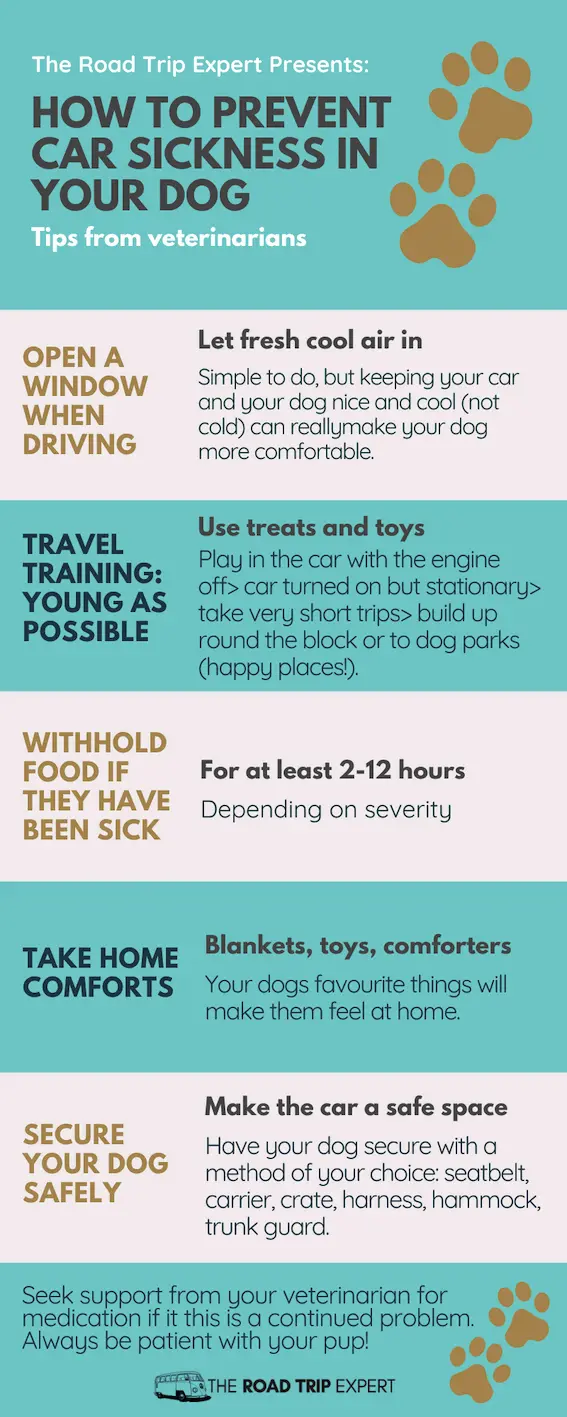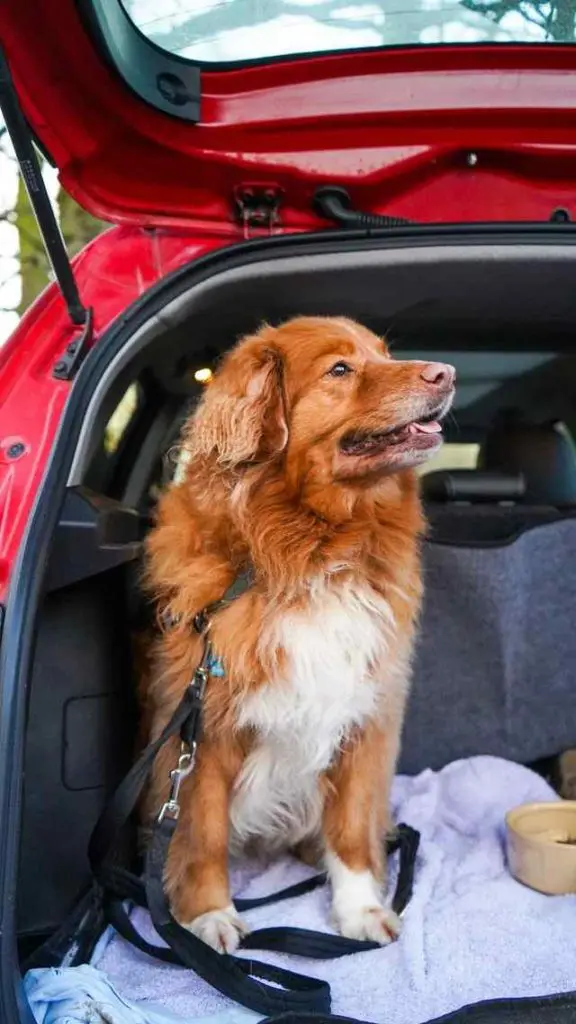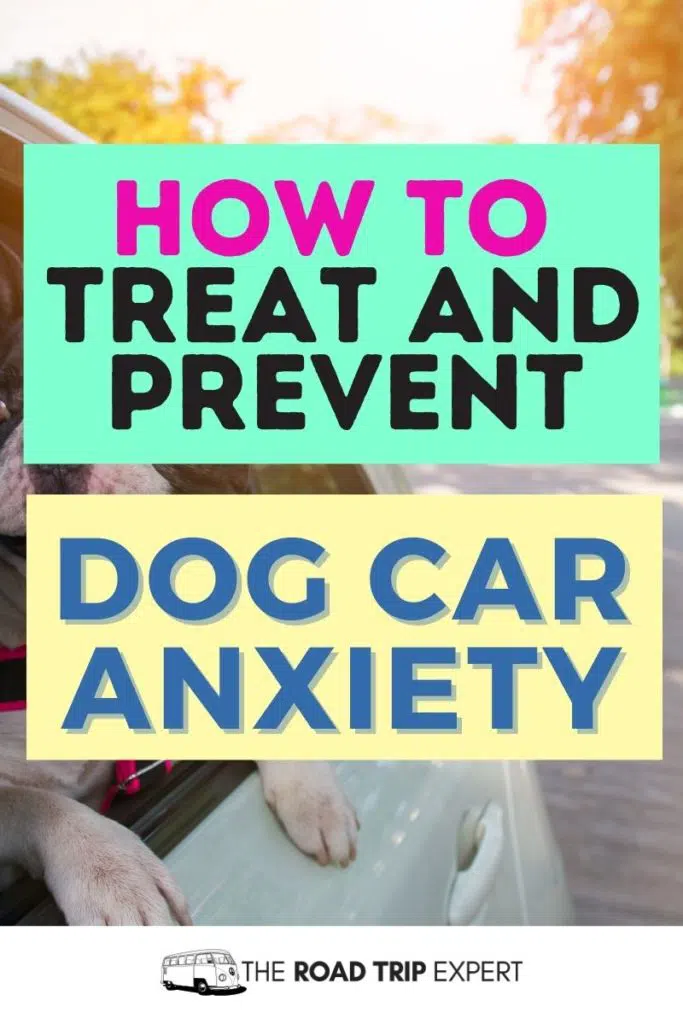Car sickness in dogs is closely related to motion sickness and travel anxiety. It’s possible for the symptoms and discomfort your dog is experiencing to be caused by stress and anxiety as well as from motion sickness.
Whether on a short ride to a park or a long vacation, dog car sickness causes, symptoms, and treatment are something to be educated on. Car and motion sickness in dogs is common, and reading up will ensure minimal anxiety and a stress-free journey for you and your canine companion.
Car sickness can be caused by stress/anxiety, or motion sickness (common in puppies), or a combination of both. It doesn’t always result in vomiting, but one unpleasant experience traveling in the car can result in associated anxiety and a stressful cycle of your dog being unwell if not solved.
It’s possible that there are other causes for your dog showing signs of discomfort. We would always recommend speaking to your veterinarian for advice if you are concerned about the well-being of your dog. However, when planning a car trip with your dog, read this for helpful pointers.
I have compiled this article from veterinarian resources to include causes of dog sickness (and motion sickness), car anxiety, symptoms, signs, prevention strategies, and treatment.
Affiliate Disclosure: Thank you for supporting The Road Trip Expert. When you purchase through links on this site, we may earn an affiliate commission. Please see our advertising disclosure for more details.
Causes of Dog Car Sickness

Travel anxiety, previous traumatic experiences, or stressful car associations can all contribute to general dog car sickness. Overexcitement, or lack of travel training can also be a cause, as can general motion sickness. According to veterinarians, motion sickness (more common in puppies and often outgrown), is thought to be caused by conflicting signals between a dog’s brain balance center and eyes.
Some veterinarians hypothesize that not being able to see out of a window can cause confusion in your dog’s sensory signals resulting in motion sickness and potentially vomiting (eyes reporting no movement but their balance center in the inner ear can feel the motion of the car). Try a dog car booster seat to avoid this.
Many dogs have had a traumatic experience in the car such as a trip to the vet an early age. Then, as a result, associated anxiety can occur on further trips, leading to car anxiety and potential sickness. Some dogs are extremely anxious in the car but do not get physically sick.
Read on for information about common signs and symptoms of your dog being unwell in the car.
Symptoms and Signs of Dog Car and Motion Sickness
Unfortunately, some dogs suffer from vomiting or diarrhea. Other warning symptoms and signs of dog car and motion sickness are whining, pacing, lip licking repeated yawning, abnormal drooling, trembling, or shaking. Restlessness, agitation, fatigue, and inactivity are also symptoms. Car sickness symptoms should ease in your dog when the car stops moving, or when it is less anxious, so if you notice them, pull over and stay calm.
Symptoms and signs of Dog Car Sickness include:
- Trembling/shaking
- Drooling
- Vomiting
- Diarrhea
- Excessive yawning
- Restlessness and pacing
- Fatigue
- Lip licking
The good news is there is a lot that can be done to prevent these symptoms. Read ahead to find out!
How To Prevent Dog Car Sickness

Withholding food from your dog at least 2 hours before car travel is a top veterinarian tip for preventing car sickness. Travel training or car conditioning is highly recommended by vets and dog owners to reduce dog anxiety and stress levels. A cool, calm car, a secure seat belt or carrier for your dog, and plenty of home comforts are also ideal. Talk to your vet about Cerenia® if the sickness persists.
Travel training your dog can take weeks or months, but it is worth it to reduce stress. Begin training as soon and as young as you can.
- Be patient with your dog, never scold
- Keep the car calm (no loud music!)
- Withhold food
- Travel Training is essential
- Make the car their safe space
- Walk your dog before you travel to allow them to burn off energy
- Speak to your veterinarian about the prescribed medication
Furthermore, protect the safety of your dog by educating yourself on Leaving Your Dog In A Car.
Treatment For Dog Car Sickness
If symptoms persist after you’ve taken steps to calm, travel train, and comfort your dog, contact your veterinarian. Discuss the possibility of using Cerenia® (maropitant), an anti-nausea treatment for dog car sickness. Vets can also advise on medications for sedation and reducing drooling, including the human antihistamine medications Meclizine, Diphenhydramine (Benadryl ®), and Dimenhydrinate (Dramamine®). Other remedies are listed below.
Please note that Cerenia and the antihistamines may cause drowsiness and a dry mouth for your dog. Anti-anxiety medications can also be discussed with your vet along with behavioral conditioning and travel training.
Other remedies (including natural) to treat dog car sickness and car anxiety:
- Ginger (in extract form; discuss with the vet as some health concerns contraindicate it)
- Lavender or Chamomile essential oils (a few drops on a cotton wool ball to scent the car; do not let your dog near it or risk ingestion)
- CBD oil (always discuss with your veterinarian)
- Calming Chewable Tablets such as Solliquin or Composure
- Pet Rescue Remedy
- Spray Adaptil pheromone travel spray on the car/crate/bedding 15 minutes before your dog goes in the car
Always consult with your vet before use!
What Are The Signs Of Dog Car Anxiety?

It is not uncommon for dogs to suffer from travel anxiety when on a car ride. Signs and symptoms include whining, barking, and car sickness or vomiting. Excessive drooling, reluctance to enter the car, and restlessness are also signs. Pay attention to your dog so that you can recognize the signs of car anxiety and take action to minimize their stress and suffering.
It’s possible that your dog’s car sickness is caused by anxiety and stress as opposed to motion sickness (or a combination). A good way to identify this is to look for signs of stress and anxiety from your dog just from being in the car before you start driving anywhere.
Dog Car Anxiety Signs
- Reluctance to get in or stay in the car
- Signs of stress and anxiety before the car has begun moving indicate an aversion just to being in the car.
- Aggression and destructive behavior
- Pacing
- Urinating or defecating
- Trembling or shaking
- Restlessness and barking
- Whining or making unusual noises
- Excessive lip-licking
What Are The Causes Of Dog Car Anxiety?
Dogs can experience anxiety and stress in cars from an association with a past negative experience, motion sickness, or a variety of other factors including separation from the owner and general fear. Your dog may associate being in the car with a previous bad trip to the vet, or perhaps it is the unusual and sometimes loud environment.
Being aware of the potential causes of travel anxiety in dogs will help you understand your dog better and hopefully prevent their discomfort whilst taking a trip.
Causes of Dog Car Anxiety
- Motion sickness caused by the movement of the car
- Being in an unusual or loud environment
- Separation from the owner
- General fear of being locked up in the back
- Negative association with cars following a previous bad experience
- Relating a car ride with a negative experience such as visiting the vet
How Can I Calm My Dogs Anxiety In The Car?
Calm your dog’s car anxiety by spending time with your dog in the vehicle while stationary, and filling their travel crate with blankets and home comforts. Don’t feed your dog 2 hours before driving and exercise for 15 minutes prior to departure. Spray dog pheromones or lavender oil in the car to create a relaxing stress-free environment
How To Help A Dog Overcome Car Anxiety (Step-By-Step)
One method to help a dog overcome car anxiety is by using a structured training and counterconditioning plan. The aim is to help your dog become more comfortable traveling in the car by gradual exposure and rewards for good behavior.
Counterconditioning involves reassigning your dog’s attention in the stressful environment to something more favorable such as the owner, or a toy. Another method is desensitization, which involves slowly exposing the dog to a stressful situation and issuing rewards for a good behavioral response.
- Start by making the car a more comfortable environment for the dog. Fill the place where your dog will be secured with home comforts, toys, and blankets
- Practice walking from the house and allowing the dog to enter the car for a short period of time whilst stationary. Leave the doors open and wait a few minutes with them. Let the dog jump back out if they want. Make sure to give the dog attention so they are focused on you instead of the stress of entering the car
- Next, walk with the dog from the car and allow them to enter. This time close the door/boot, but stay visible with the dog and allow them to leave if you notice signs of distress. The key is to try and keep their focus on your, and gradually build up the time until they are comfortable sitting in a stationary car.
- finally, practice walking from the house, securing the dog in their place, then sitting in the front seat of the stationary car.
- If the dog is comfortable with being secured in a stationary car, you are now ready to start driving short distances. Gradually build up to longer distances.
- At each stage, reward your dog for good behavior with lots of treats and cuddles.
Check this article out if you are planning a long road trip with your dog!
How To Secure Your Dog In A Car To Prevent Anxiety
There is more than one way to safely secure a dog in a car. You might find that different methods induce different responses from your dog and as such, you can reduce car sickness and anxiety by trying alternative methods. It is important to ensure that your priority is the safety of the dog so make sure you follow the instructions carefully.
Here is an article explaining different ways to secure your dog in a car.
Disclosure: Some of the links in this article may be affiliate links. This means I earn a commission if you make a qualifying purchase, but this is at no additional cost to you. Thank you for supporting The Road Trip Expert.
Disclaimer: You are using The Road Trip Expert website at your own risk. None of the authors, contributors, administrators, or anyone else connected with theroadtripexpert.com website in any way whatsoever can be responsible for your use of the information contained in or linked from these web pages.


